The Location of Meidaizhao Temple (美岱召)
If you are planning Inner Mongolia tour, a side trip to Meidaizhao either from Baotou or Hohhot is highly recommended. Meidaizhao Monastery ( (美岱召) is located in Meidaizhao Village below the massive Daqing Mountain of the Yinshan Range, Tumd Right Banner, Dong He District, Baotou, Inner Mongolia.
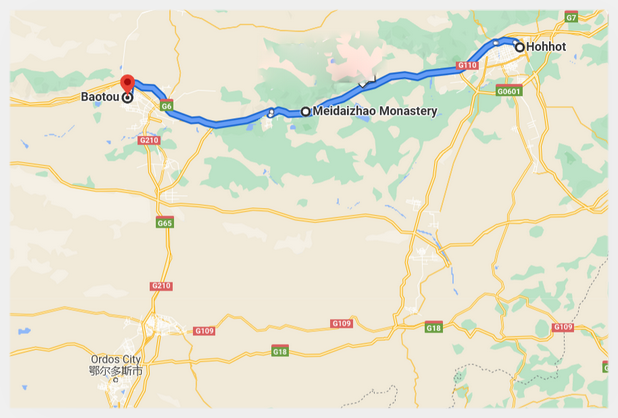
Meidaizhao Temple ( (美岱召) lies between Baotou ( 98km east of Baotou) and Hohhot ( 99km west of Hohhot), just on the north of Jingzang Expressway No.6 (or National Highway 110) , a historical site conveniently accessible either from Hohhot or Baotou.
Add: Meidaizhao Village, Meidaizhao Town, Tumd Right Banner, Baotou City, Inner Mongolia
内蒙古自治区包头市土默特右旗美岱召镇美岱召村
Tel: 0472-8850012
How to Get to Meidaizhao Monastery & Tickets
You can take train either from Hohhot or Baotou to Salaqi Railway Station (萨拉齐站) . Salaqi Station is located in Salaqi Town, Tumed Right Banner, Baotou City and it is on Jibao Railway Line, a third class station under the jurisdiction of Hohhot Railway Bureau, built in 1922.
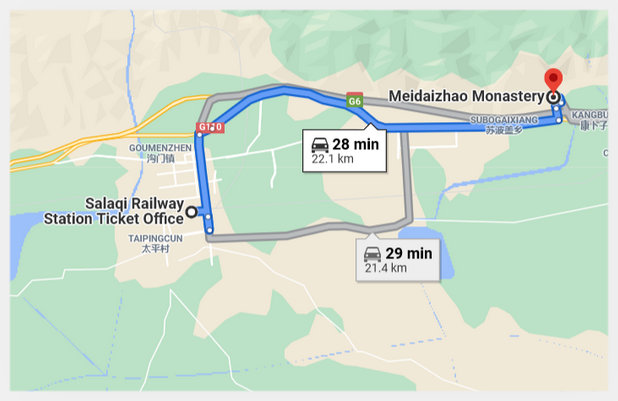
Arriving a Salaqi Train Station out, go west, to the intersection of the overpass, and wait on the road for Minibus No.6 ( 5 yuan ) for Meidai Zhao Village. Alight at Meidaizhao Village, you will see a memorial arch in front of the village, after the memorial arch go straight ahead, a few minutes later you can see Meidai Zhao Monastery.
Alternatively you also can take the long-distance buses either from Baotou or Hohhot.
Entrance ticket:
30 yuan/person
Open time:
09:00-17:00
09:00-16:00 (ticket collection Time) (Monday – Sunday, January 1st – December 31st)
ABCs of Meidaizhao Monastery
“Meidaizhao” literally means “Maitreya Temple” in Mongolian ( Zhao means “temple”). Meidaizhao Monastery was originally built in 1565 as a fortified capital city of the Daming Golden Kingdom (大明金国) in Ming Dynasty, also known as Altan Khan Kingdom (阿勒坦汗国), (a vassal of Ming Dynasty) established by Altan Khan (1507 – 1582) .
Altan Khan (阿勒坦汗) was a descendant of Kublai Khan (1215–1294). He managed to unite the Mongols in the north and the south. His name means “Golden Khan” in the Mongolian language, hence the kingdom’s name.
In 1571, Altan Khan was granted the title Shunyi Wang (顺义王) from the Longqing Emperor (March 4, 1537- July 5, 1572), the 12th emperor of China (Ming dynasty). With the assistance of his wife known as Sannianzi (三娘子) (Grand Queen), the Daming Golden Kingdom kept peace peace with the Ming Dynasty for over 40 years.
With a new city known as Hohhot(“Green City) built by Altan Khan and the Grand Queen in the current old town in Hohhot, the political center of Altan Khan Kingdom was move on to Hohhot.
In 1606, the Meidaizhao fortress was transformed into a lamasery. So Altan Khan was the founder of the original city of Hohhot which literally means “green city” in Mongolian.
The Layout of Meidaizhao Temple
The present temple occupies an area of 4000 square meters encompassing the over 200 Ming and Qing era buildings including Sakyamuni Hall (Hall of Great Hero), Glazed Hall, Dalai Temple, Sannianzi Hall.
The temple is surrounded by a 5-meter high stone wall in a rectangular shape with a perimeter of 681 meters. The big draw is the 1650-square-meter murals in Ming and Qing Dynasties preserved in the Hall of Great Hero.
Virtual Tour of Meidaizhao Temple
If you are planning Inner Mongolia tour, a side trip to Meidaizhao either from Baotou or Hohhot is highly recommended.
Follow me to have a virtual tour of the ancient city of Meidaizhao Temple.
The Entrance to Meidaizhao Temple
The south gate to the fortress temple and Daqingshan Mountain lies behind the temple.
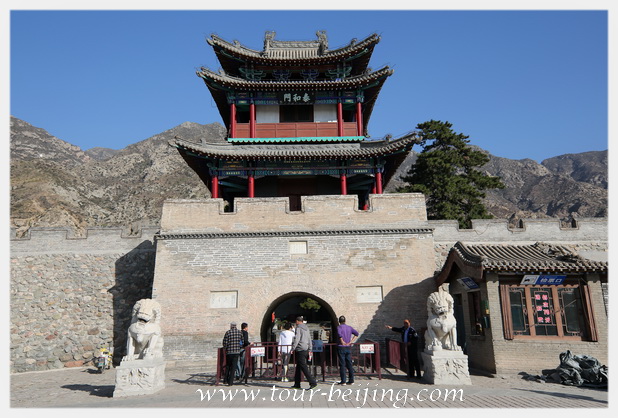
Listening to Buddhist Scripture” Pine Trees
The two old pine trees in front of the Great Hero Hall ( Sakyamuni Hall ) are known as “Listening to Buddhist Scripture” pine trees, west is female and east male, over 400 years old when the temple was originally started being built.
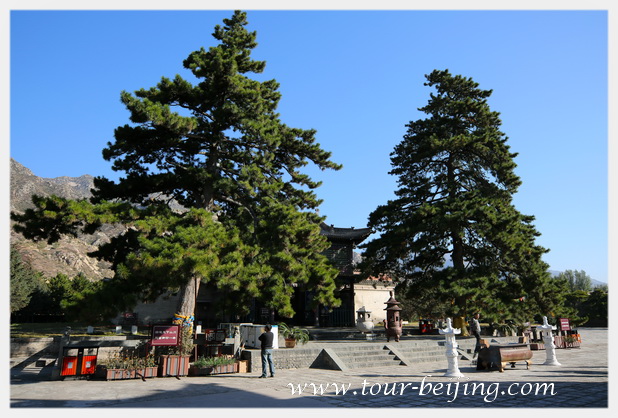
Sakyamuni Hall 大雄宝殿
Sakyamuni Hall has three connected halls with two floors and 3 double eaves. The roofs of the three halls are in the gable style. The east, west and south sides of the hall are surrounded by white Tibetan brick walls, forming an architectural body combining Han and Tibet. The lower part of the west wall of the Temple is a group of Mongolian nobles worshipping Buddha.
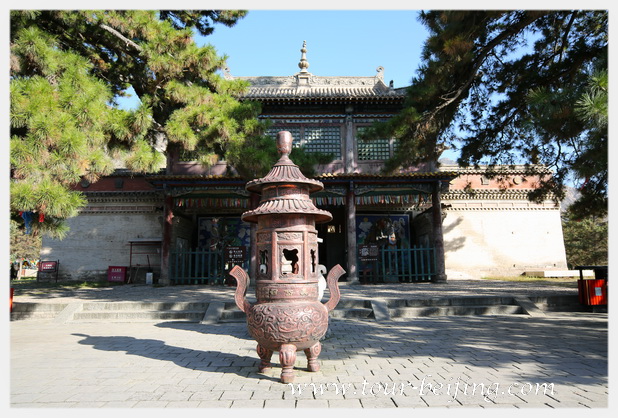
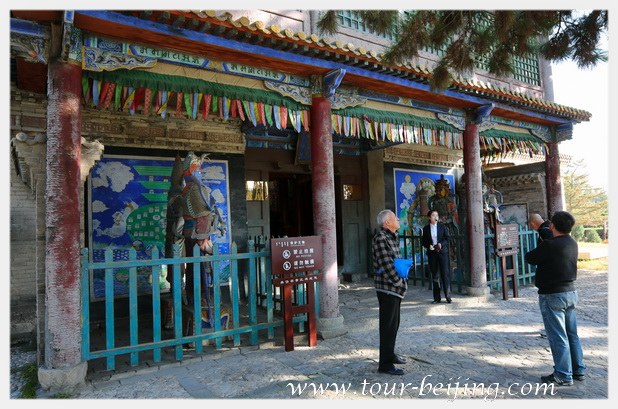
Sakyamuni Hall has the priceless mural in the main hall starting from the waist line to the ceiling. The mural scene is grand. You need to look up to see it. In the middle of the north wall is painted the giant statue of Sakyamuni, and the background is painted with sakyamuni’s story of Buddha. Under the wall of the four Kings and Fu Hu Arhat, the cloth bag monk.
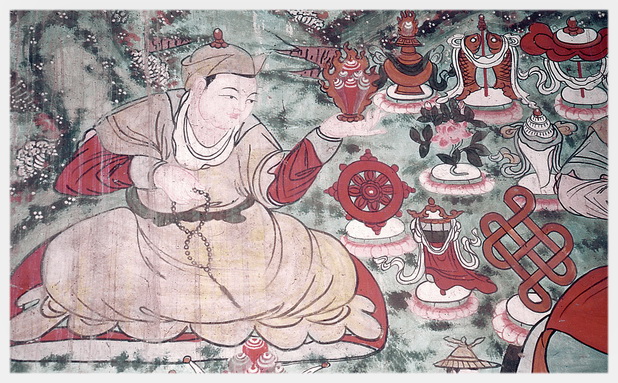
Many of the Mongolian costumes on these mural paintings can be found in the Book of Yi Custom written by Xiao Daheng in Ming Dynasty. It is a valuable material for studying Mongolian history, folk customs and costumes in Ming and Qing Dynasties.
The Nai Qiong Temple 乃琼殿
The Nai Qiong Temple is the former dwelling place for Mal Da Li living Buddha (四世达赖的代表人麦达里活佛在此坐床传佛) in Qing Dynasty. The original statue of Mal Da Li is not available. Instead, it shrines the statue of Guardian of God.
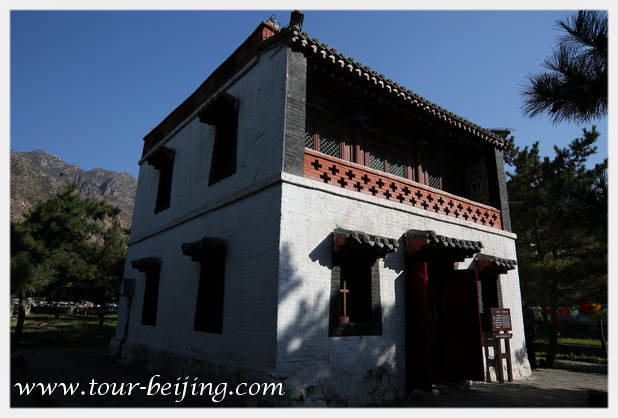
The Glazed Hall (Liuli Hall) 琉璃殿
Built in 1566, the Glazed Hall (Liuli Hall) was formerly the meeting hall of Altan Khan Kingdom. Now it is devoted to Three Buddhas, a typical Ming architecture.
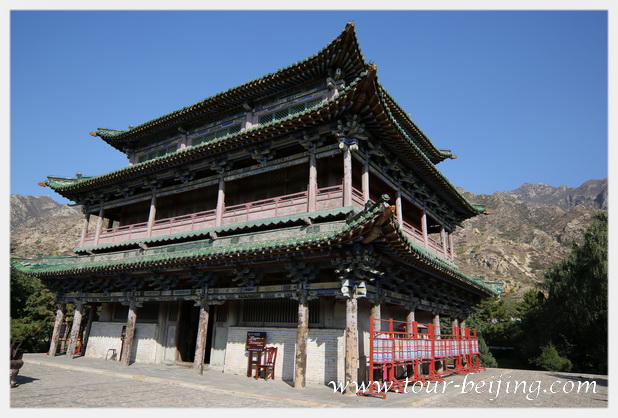
The Dalai Temple 达赖庙
The Dalai Temple is given to the Third Dalai Lama – Sonam Gyatso who came here in 1582 for practicing Buddhism and held a new funeral ceremony for Altan Khan. The title of Dalai Lama was given by Altan Khan.
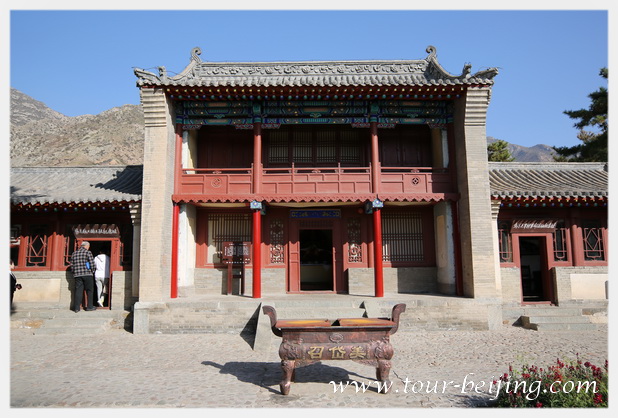
The Grand Queen Hall 太后庙
The Grand Queen Hall, a burial place for the third wife ( also known as Sannianzi) of Altan Khan. She assisted her husband managing the kingdom and keeping good relationship with the Ming Dynasty for over 40 years.
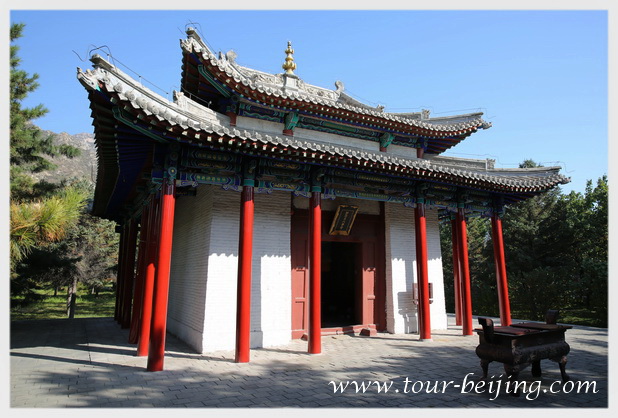
The Grand Queen Hall is surrounded by columns of the funeral hall style building, the funeral hall of the third wife ( also known as Sannianzi) of Altan Khan. The original 1-meter-high sandalwood tower covered with a pot was removed in 1966. When it was removed, it was discovered that there was an underground palace under the tower. In the palace, there was a bag of ashes, three combs, six rosaries, a triangular silver-plated medicine box and two pairs of diamond ears.
In the Grand Queen Temple, there are murals painted in the Ming Dynasty, Mongolian costume figures in the picture,. The legend goes that there are the portraits of Alta Khan and the Grand Queen in the murals.
The statues of Alta Khan and the Grand Queen ( Sannianzi – third wife).
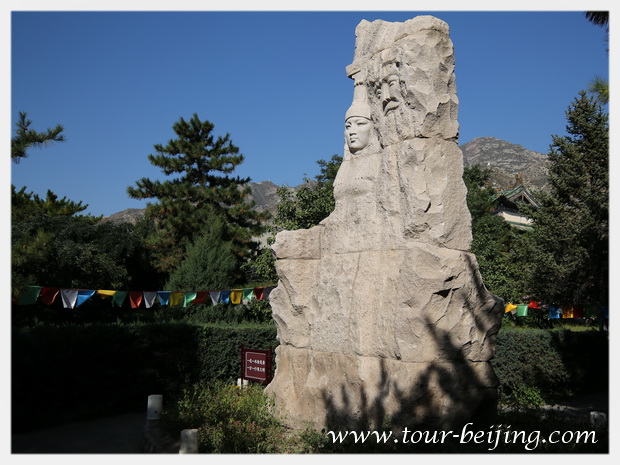
An ancient city 古城
Meidaizhao Temple was originally an ancient city in an irregular square shape. The south gate is the main gate.
The fortified temple stands facing the south below Daqing Mountain on the north, surrounded by a 681-meter long stone wall, 5 meters high. Ascending the wall, you are able to have a clear picture of the ancient city, a former capital of Altan Khan Kingdom.
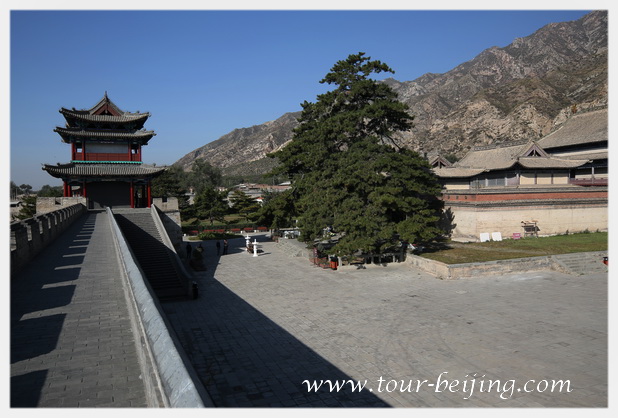
The northern wall of the temple below the Daqing Mountain (大青山).
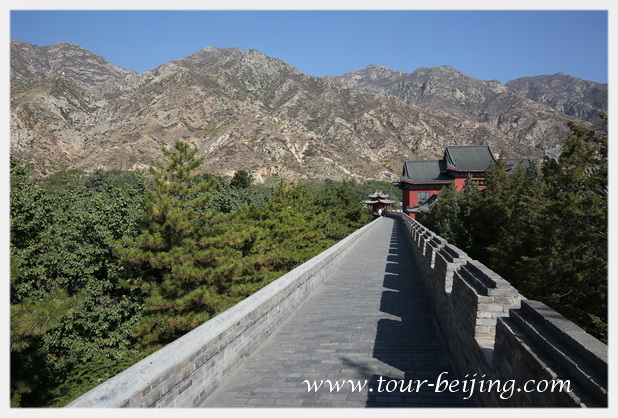
One of the corner towers ( Turrets) on the wall
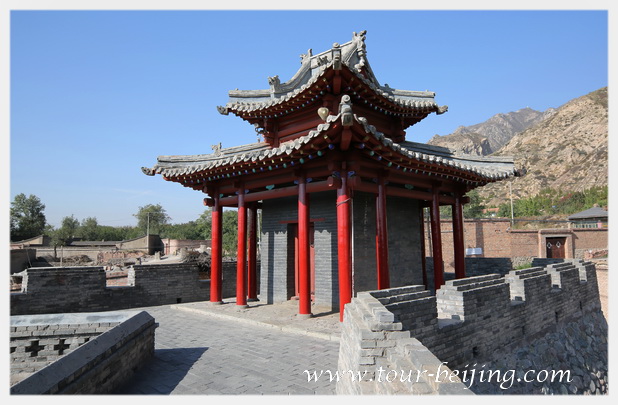
Standing on the wall, you are able to have a clear picture of the Sakymuni Hall and Glazed Hall.
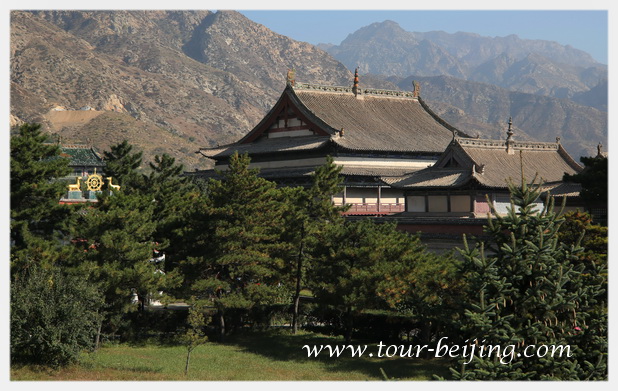
Tip: Hassle-free Hohhot & Inner Mongolia Guided Tours
If you don’t want to go the do-it-yourself route and prefer the hassle-free escorted tours, here are some options for guided tours to Inner Mongolia:
Inner Mongolia Tour
Mid-Inner Mongolia Tour (Hohhot, Baotou, Ordos)
East Inner Mongolia Tour (Xanadu,Wulan Butong, Xilinhot, Chifeng)
Northeast Inner Mongolia Tour (Hulunbuir)
West Inner Mongolia Tour (Alashan “Alxa” League)
Hohhot Tour
Hohhot Highlights & Grassland 3 Day Tour
Hohhot Highlights & Grassland 2 Day Tour
Further Readings
Top Places to Visit in Inner Mongolia
Top 10 Attractions in Hohhot
Best Time to Visit Hohhot
Meidaizhao Temple
How to go to Hohhot from Beijing
Top Souvenirs in Hohhot
Hohhot Taxi: Hohhot Taxi Fares, Tips and Phones
Baotou Taxi: Baotou Taxi Fares, Tips and Phones
Ordos Taxi: Ordos taxi Fares, Tips and Phones
What to see in Hohhot, what to do in Hohhot
Top 10 Attractions in Alxa League
Heicheng Historic Site in Ejin Banner (Tips, Photos & Map)
Guai Shu Lin in Ejin Banner, Inner Mongolia (Tips, Photos & Map)
Populus Forest in Ejin Banner (Tips, Photos & Map)
Badain Jaran Desert (Tips, Photos & Map)
The Quiet Wusu Langzi Lake
Dujuan Lake in Aershan National Forest Park
Beihu Park Skyline at Night in Manzhouli
Architecture of Manzhouli
Sunrise Glow over Hulunbuir Grasslands.
Top 10 Places for Photography in Hulunbuir
Top 10 Attractions in Hulunbuir.
Road Trip from Ergun to Linjiang Village
Hulun Lake Travel Tips
World Anti-fascist War Hailar Memorial Park
Architecture of Manzhouli
Ergun Travel Guide
Aoluguya Travel Guide
Moerdaoga Travel Guide
Shiwei Travel Tips
How to visit Hulunbuir Grassland
Top 10 Attractions in Chifeng
Xanadu Sites Museum
Jinlianchuan Grassland
Wulan Butong Grassland
Asihatu Stone Forest
Gong Geer Grassland
Duolun Travel Guide
Xanadu Travel Guide – Shangdu Travel
How to visit Asihatu Stone Forest
Xi Wuzhumuqin Grassland
Any questions, just drop a line.





